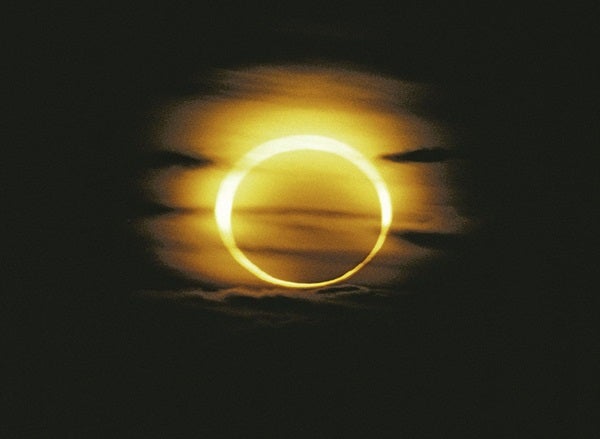The first solar eclipse of 2008, an annular type, occurs February 7. Both the Sun and Moon will lie in front of the stars of Capricornus the Sea Goat. Observers lucky and hardy enough to travel to parts of Antarctica or southern regions of the Pacific Ocean will see the event.
An annular eclipse occurs when the Sun, Moon, and Earth line up, with the Moon in the middle. Unlike a total solar eclipse, the Moon lies too far from Earth to cover the Sun’s entire disk. The Moon’s distance from Earth changes from a maximum of 252,166 miles (406,720 kilometers) to a minimum of 220,950 miles (356,371 km) during the course of each month.
Skygazers in the southeastern third of Australia, all of New Zealand, and most of Antarctica will see a partial eclipse. This larger region is where the Moon’s lighter, outer shadow (called the penumbra) falls. During total solar eclipses, the darker, inner shadow (the umbra) covers areas that experience totality.
The annular path begins in Antarctica at 3h20m Universal Time (UT), when the Moon’s shadow meets Earth and forms a 360-mile-wide (581 kilometers) corridor near the base of the continent’s peninsula region. Traveling westward, the shadow quickly crosses Antarctica and turns north as it heads into the Pacific.
Greatest eclipse takes place at 3h55m05s UT, when the Moon spans 96.5 percent of the Sun’s diameter. At this instant, the annular eclipse’s duration is 2 minutes 12 seconds, the path width is 275 miles (444 km), and the Sun lies 16° above the ocean’s featureless horizon.
The eclipse’s central path continues north before gradually curving eastward. The event ends at local sunset at 4h31m UT.
During the eclipse’s 1 hour 10 minute duration, the Moon’s antumbra (called that because the umbra never reaches Earth’s surface) travels approximately 3,470 miles (5,600 km) and covers 0.5 percent of Earth’s surface.
Several things make this eclipse unusual. First, it begins and ends along Earth’s sunset line. And second, most eclipse paths travel from west to east. The February 7 annular eclipse path begins by running east to west and slowly turns north before finally moving west to east near its end point.










